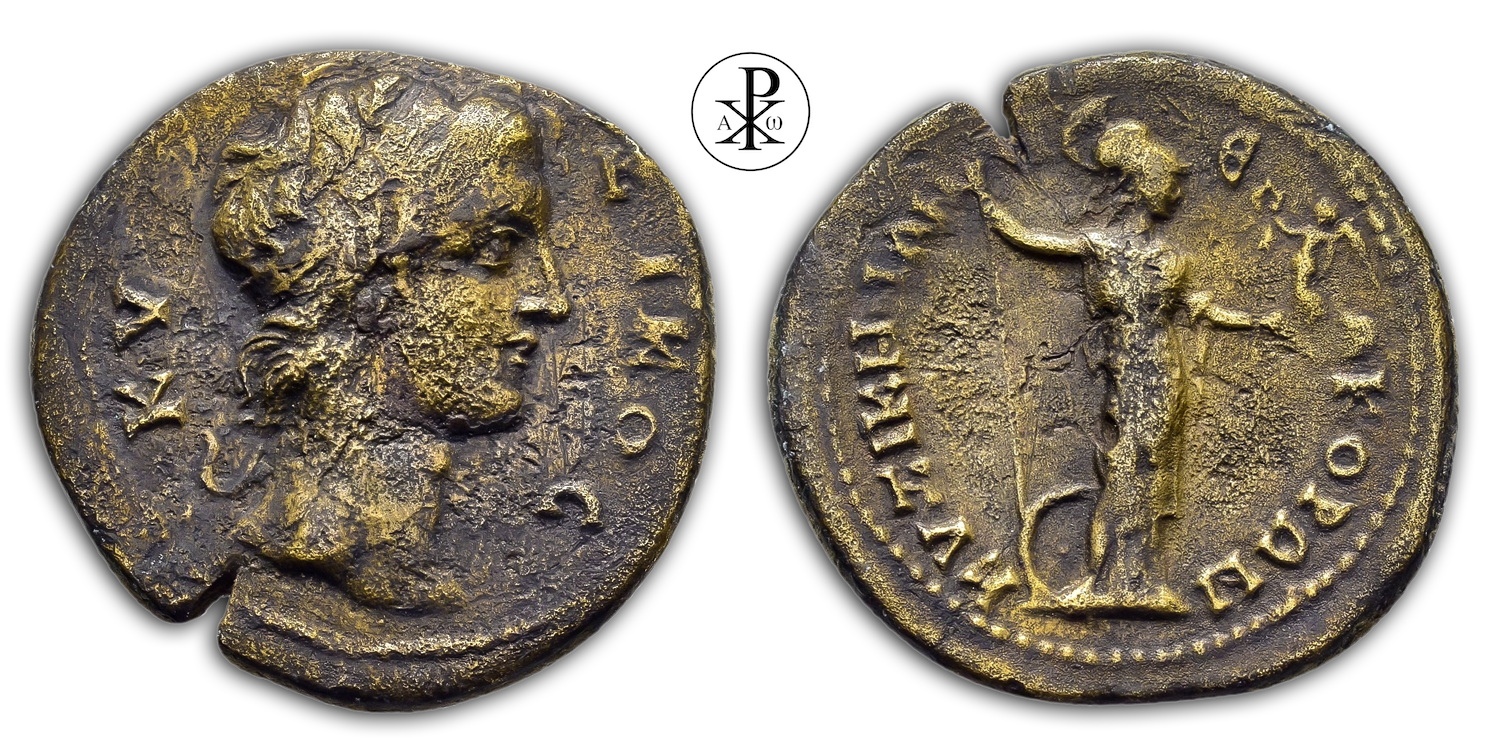Imperator Caesar Marcus Aurelius Commodus Antoninus Augustus
Reign: Pseudo-autonomous; time of Commodus
Mint: Cyzicus, Mysia
Date: 180/192 AD
Nominal: Bronze
Material: AE
Diameter: 28mm
Weight: 10.20g
Reference: RPC IV.2 25001 (this coin)
RPC Online: https://rpc.ashmus.ox.ac.uk/coins/4/25001
Rare: Specimens 1 (0 in the core collections)
Provenance: Biga Numismatics Drunen, Netherlands (Auction 17, Lot 173)
Pedigree: –
Special: Only known example, RPC Online Plate coin
Obverse: Diademed head of hero Kyzikos (youthful), right
Inscription: ΚVΖΙΚοϹ
Translation: [King and Hero] Kyzikos
Reverse: Athena standing, right, holding spear and Nike; beside, shield
Inscription: ΚVΖΙΚΗΝΩΝ ΝƐΟΚΟΡΩΝ
Translation: Kyzikenon Neokoron
Translation: City of Cyzicus, one Honorary title for an emperor Temple
Comment: Kyzikos (Latinised Cyzicus) was a Greek city on the southern coast of the Sea of Marmara in the ancient landscape of Mysia; today Balız near Erdek in the province of Balıkesir (Turkey). The city was situated on the isthmos of the Arktonnesos peninsula and owed its prosperity to the double harbour and large territory thus created. The city is named after the eponymous founder Kyzikos, the king of the Dolions, who was allegedly killed by the Argonauts. In 74 BC the city was unsuccessfully besieged by Mithridates VI (Pontos). Sulla, and later confirmed by Gnaeus Pompeius Magnus, gave it the status of a free city after the Mithridatic Wars. Having already temporarily lost its freedom under Augustus, the city was finally incorporated into the province of Asia under Tiberius. Cyzicus could also boast of being one of the “Neokoroi cities”. The original Greek term Neokoros applied to a temple guard or temple priest. Derived from this, it became an honourary title, especially of Asia Minor cities that had received permission from Rome to build a temple for the Roman emperor (in the case of Cyzicus, for Hadrian). This title was highly coveted and sparked a competition among Asia Minor cities to be allowed to use it. Some cities received the title more than once and pointed to this honour, especially on coins. There were approximately 37 cities holding the neocorate, concentrated in the province of Asia, but also in neighboring provinces. The attainment of the title was an extremely important event and was often celebrated with splendid events.
Pictured on the obverse of the bronze coin presented here is the eponymous king and hero Kyzikos (shown here as a youth). He is the young king of the Dolions on the Propontis in the Argonaut saga (it is about the voyage of Iason and his companions to Colchis in search of the Golden Fleece and its theft) of Greek mythology. He is the son of Aineus and Ainete, the daughter of Eusoros, or of Eusoros himself, and married to Kleite, the daughter of Merops. Since they were married only a short time before, the marriage is still childless. According to another version, however, he leaves sons (Hyginus, Fabulae 16). Larisa, daughter of Piasos, is also named as his bride. Kyzikos is the founder and king of the city of Kyzikos, which is named after him. He kindly welcomes the Argonauts on their way to Colchis in his city and provides them with rich supplies for their onward journey. When the Argonauts are unknowingly driven back to the coast of the Dolions by adverse winds in the dark of night, a battle breaks out between the Dolions and the Argonauts, as both sides do not recognise each other and consider them to be hostile strangers. In the course of this battle, Kyzikos is accidentally killed in action by Iason (or Heracles), who does not recognise his friend in the blackness of the night. When the Argonauts realise their mistake the next day, they give him a solemn burial.
The veneration of the mythical founder of the city was still very much alive in the sixties of the 2nd century AD. After an extremely severe earthquake, the city was rebuilt in a way that was almost like a new foundation. The erection of a statue of the hero Kyzikos in the rebuilt theatre revived or at least modified the attitude of the people of Kyziken that had come to light in the 30s at the beginning of the imperial period. At that time, the city had accepted and even praised that the importance of its founding hero was diminished in favour of newer and more present benefactors who claimed and received the title of founder. With the gradually strengthening movement of the second sophism, however, Cyzicus was also to find its way back more strongly to its old Greek traditions, which gave the city the dignity of high age and at the same time linked it to a respected tribe of the Greek motherland. And gradually the Greek cities and their notables discovered and felt that the imperial house and the Romans had not come only as benefactors of the Greeks. The Cyzicans in particular had had their experiences under Augustus and Tiberius. The prominence of the hero Cyzicus on the Cyzician coins since Emperor Domitian obviously has to do with the second sophism just mentioned and the collection, ordering, elaboration and propagation of urban patriotic traditions within the framework of this movement. By recalling its own traditions and former Greek greatness, this movement attempted, partly consciously, partly unconsciously, to organise and strengthen the self-confidence of the Hellenic world of the East, which was dominated by Rome (Johannes Nolle, Kyzikos und sein eponymer Heros).
